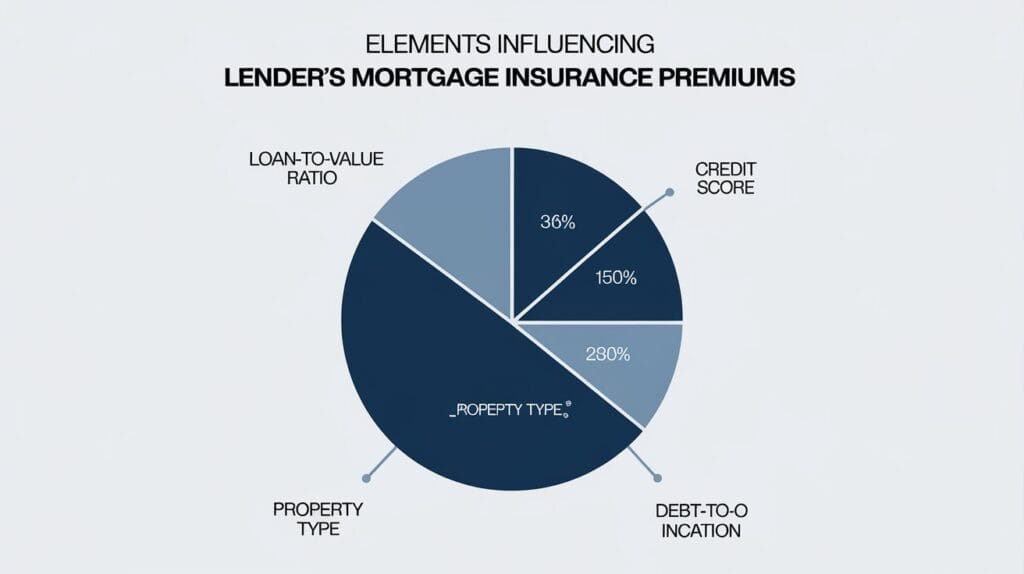Physical Address
304 North Cardinal St.
Dorchester Center, MA 02124
Physical Address
304 North Cardinal St.
Dorchester Center, MA 02124

Lenders Mortgage Insurance (LMI) plays a pivotal role in the home-buying landscape, particularly for those who are unable to provide a substantial down payment. Essentially, LMI is a safeguard for lenders against the financial risk posed by borrowers who default on their loans.
When individuals apply for a mortgage with a smaller deposit, typically less than 20% of the property’s value, lenders face increased risk. LMI serves to transfer this risk to an insurance provider, making it feasible for lenders to extend loans to a broader range of borrowers.
This insurance allows more individuals to achieve homeownership, even if they have not accumulated a large deposit.
For first-time homebuyers, in particular , LMI can be the gateway to entering the housing market sooner rather than later.
However, it’s crucial to recognize that the cost of LMI is often borne by the borrower, adding to the overall expense of buying a home.
LMI premiums are not uniform and can vary based on several key factors, including the loan amount, the size of the deposit, and the loan-to-value ratio.
As a rule of thumb, the smaller the deposit, the higher the premium will be. This makes it essential for potential homeowners to plan their finances meticulously and understand how LMI will impact their mortgage repayments over time.
By grasping the intricacies of Lenders Mortgage Insurance, borrowers can make more informed decisions, tailoring their financial strategies to minimize costs and maximize the benefits of their mortgage options.
Lenders Mortgage Insurance serves a crucial function in the mortgage landscape by enabling lenders to offer loans with smaller down payments. When a borrower puts down less than 20% of a property’s value, the lender assumes a higher level of risk.
LMI mitigates this risk by transferring it to an insurance provider, thereby allowing the lender to approve more loans than they otherwise might.
This insurance makes it possible for more individuals to achieve homeownership, even if they haven’t managed to save a large deposit. By spreading the financial risk, lenders can maintain a healthier balance sheet, which can benefit the broader lending market.
LMI essentially acts as a safety net, assuring lenders that they will be compensated if a borrower defaults on the loan.
In practical terms, this means that many people, especially first-time homebuyers, can enter the housing market sooner. Without LMI, the requirement for a large down payment could be a significant barrier for many potential buyers.
Therefore, while it does add to the overall cost of buying a home, LMI also broadens access to mortgage financing.
It’s also worth noting that LMI varies by lender and is influenced by multiple factors, such as the loan amount and the size of the deposit. This variation allows lenders some flexibility in how they structure their loan products, which can be advantageous for borrowers in different financial situations.
Understanding the purpose of LMI can help borrowers better appreciate why this expense is part of their mortgage journey.
Lenders Mortgage Insurance costs are influenced by several key factors, primarily the loan amount and the deposit size. Typically, LMI premiums are a percentage of the loan amount, which can vary significantly.
For example, a borrower with a 10% deposit will likely face a higher premium than someone with a 15% deposit due to the increased loan-to-value ratio (LVR). The higher the LVR, the greater the risk for the lender, which translates to a higher insurance cost.
Another critical factor is the lender’s specific policies and their agreements with insurance providers. Different lenders may have unique pricing structures, so it can be beneficial to compare options.
Borrowers with strong credit scores and stable employment histories might find themselves eligible for lower LMI premiums, as they represent a lower risk to lenders.
Additionally, the location of the property can also impact LMI costs. Properties in areas with historically higher default rates may incur higher premiums.
It’s essential for borrowers to be aware of these variables when estimating the total cost of their LMI.
Being mindful of these factors can help potential homeowners better prepare for the added expense of LMI, allowing them to plan their finances more effectively and explore options to potentially reduce the premium.

Lenders Mortgage Insurance premiums are influenced by several key factors. One primary factor is the loan-to-value ratio (LVR), which is the loan amount compared to the property’s value. A higher LVR indicates a higher risk for the lender, resulting in steeper premiums.
The loan amount itself also plays a significant role; larger loans generally attract higher LMI costs. Another crucial element is the size of the deposit. Smaller deposits elevate the LVR and, consequently, the premium.
Lender-specific policies and their agreements with insurance providers can lead to variations in LMI costs. Different lenders may offer different premium rates based on their risk assessment criteria.
Borrowers with higher credit scores and stable employment histories are often seen as lower-risk, which can translate to reduced premiums.
Geographic location can also impact LMI premiums. Properties situated in areas with higher historical default rates may incur greater insurance costs.
Additionally, the type of property being financed can influence the premium, with certain property types considered riskier investments by lenders.
To get a clear understanding of the potential LMI premium, borrowers should consider all these factors and how they interplay.
By doing so, they can more accurately anticipate their LMI expenses and plan accordingly. Being well-informed about these elements enables borrowers to make strategic financial decisions, optimizing their mortgage terms to suit their individual needs.
While Lenders Mortgage Insurance is primarily designed to protect the lender, the financial responsibility for this insurance falls on the borrower. The cost of LMI is typically rolled into the total loan amount, meaning borrowers will pay it off over the duration of their mortgage.
This integration into the loan can simplify managing the payment, as it eliminates the need for a large upfront sum. However, this approach also means that the total amount borrowed—and consequently, the interest paid over the life of the loan—will be higher.
It’s important to note that the premium for LMI can be either a one-time payment or spread out over regular loan payments, depending on the lender’s policies. Some lenders may offer the option to capitalize the LMI premium, which involves adding the cost to the loan balance and repaying it over time.
While this may ease initial financial pressure, it does result in higher overall costs due to the accruing interest on the increased loan amount.
Given the variability in how LMI costs can be structured, borrowers should carefully review their mortgage agreements and consult with their lenders to fully understand their obligations. This awareness can help in making informed decisions that align with their long-term financial goals.
Being prepared for these additional costs can aid in better financial planning and more effective management of mortgage repayments.
Calculating Lenders Mortgage Insurance involves understanding several key variables. To start, identify the loan amount and the deposit to determine the loan-to-value ratio (LVR). This ratio is crucial as it dictates the level of risk the lender is taking on.
With the LVR established, consult the lender’s LMI rate schedule, which outlines the percentage rate associated with different LVR brackets.
For instance, if the LVR is high, the rate might be higher, reflecting the increased risk.
Next, apply this percentage rate to the total loan amount.
For example, if the loan amount is $300,000 and the LVR falls within a bracket where the rate is 2%, the LMI premium would be $6,000. This amount may then be added to the loan balance or paid upfront, depending on the lender’s policies.
It’s also important to consider other factors that might influence the final cost. The borrower’s credit score, employment stability, and even the location of the property can affect the premium rate.
Some lenders may offer discounted rates for low-risk borrowers or have special agreements with their insurance providers that could result in varying costs.
Understanding these variables and how they interact allows borrowers to better anticipate the financial commitment LMI represents, facilitating more effective budgeting and financial planning.
To avoid Lenders Mortgage Insurance, careful financial planning and strategic choices are essential. One of the easiest ways to bypass LMI is by saving a larger deposit, ideally at least 20% of the property’s value.
This significant deposit lowers the loan-to-value ratio (LVR), reducing the lender’s risk and eliminating the need for LMI.
Additionally, some borrowers might consider a guarantor loan.
In this case, a family member uses their property or savings as collateral, helping to meet the lender’s security requirements without requiring LMI.
Another option is to seek out lenders with special terms for certain professions. Some lenders waive LMI for professionals in perceived lower-risk fields, like doctors, accountants, or lawyers. These offers can lead to substantial savings but usually have strict eligibility requirements.
Also, staying updated on promotional deals or special programs from lenders can be beneficial, as they might offer LMI waivers under specific conditions.
Lastly, comparing different lenders and their LMI policies can reveal more favorable terms, providing ways to avoid or reduce LMI costs.
To lower your Lenders Mortgage Insurance (LMI) expenses, start by aiming for a larger deposit. A higher deposit reduces the loan-to-value ratio (LVR), which can lead to a lower LMI premium.
Consider setting up a dedicated savings plan to gradually increase your deposit over time.
Another effective strategy is to compare different lenders and their LMI policies. Different lenders have varying agreements with insurance providers, which can result in different premium rates.
Shopping around can help you find more competitive rates and potentially save a significant amount on LMI.
Maintaining a strong credit score and stable employment history can also positively impact your LMI costs. Lenders view borrowers with good credit and steady jobs as lower-risk, which can translate to reduced premiums.
Regularly check your credit report and take steps to improve your credit score, such as paying bills on time and reducing outstanding debt.
Additionally, look for lenders that offer special programs or promotional deals. Some lenders provide LMI discounts or waivers for specific professions like doctors, lawyers, or accountants.
These offers usually come with eligibility criteria, so be sure to check if you qualify.
Lastly, staying informed about the housing market and economic conditions can also play a role. For example, certain regions may have higher default rates, which could increase LMI costs.
Being aware of these factors can help you make more strategic decisions about where and when to buy, ultimately impacting your LMI expenses.
Lenders Mortgage Insurance (LMI) and Private Mortgage Insurance (PMI) serve similar roles in that they both protect lenders when borrowers make smaller down payments.
However, their applications and specifics differ significantly. LMI is primarily utilized in countries like Australia, whereas PMI is common in the United States.
One key distinction is how the premiums are structured and paid. With LMI, the cost is typically integrated into the loan amount, which means borrowers repay it over the life of the loan. In contrast, PMI premiums are usually paid monthly as part of the mortgage payment. This ongoing cost can be removed once the borrower’s equity in the home reaches 20%, providing some flexibility in managing long-term expenses.
Moreover, eligibility criteria and underwriting processes for LMI and PMI can vary. LMI often involves broader eligibility, making it accessible for a wide range of borrowers, whereas PMI may have stricter underwriting standards. This can influence the approval process and the associated costs.
Understanding these differences can be crucial for borrowers navigating their mortgage options. For those looking to minimize their insurance costs and optimize their mortgage terms, comprehending how LMI and PMI operate in their respective regions can provide valuable insights, helping them make more informed financial decisions.